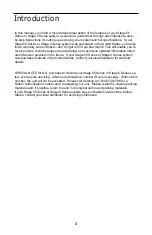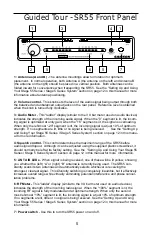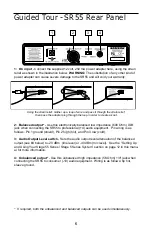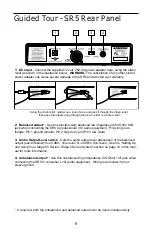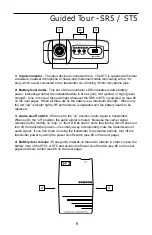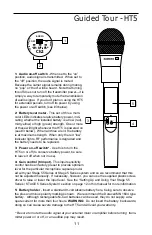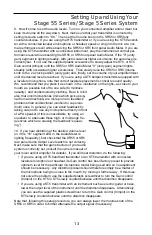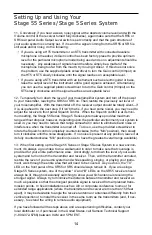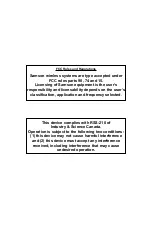
7
Guided Tour - SR5 Front Panel
1: Antenna - The antenna mounting allows full rotation for optimum placement. In normal
operation, the antenna should be placed in a vertical position. It also can be folded inward
for convenience when transporting the SR5. See the “Setting Up and Using Your Stage
55 Series / Stage 5 Series System” section on page 12 in this manual for more information
about antenna positioning.
2: Volume control - This knob sets the level of the audio signal being output through both
the balanced and unbalanced output jacks on the rear panel. Reference level is obtained
when the knob is turned fully clockwise.
3: Audio Meter - This “ladder” display (similar to the VU bar meter used on audio devices)
indicates the strength of the incoming audio signal. When the “0” segment is lit, the incom-
ing signal is optimized at unity gain; when the “+6” segment is lit, the signal is overloading.
When only the left-most “-20” segment is lit, the incoming signal is at just 10% of optimum
strength. If no segments are lit, little or no signal is being received. See the “Setting Up
and Using Your Stage 55 Series / Stage 5 Series System” section on page 12 in this manu-
al for more information.
4: Squelch control - This control determines the maximum range of the SR5 before audio
signal dropout. Although it can be adjusted using the supplied plastic screwdriver, it should
normally be left at its factory setting. See the “Setting Up and Using Your Stage 55 Series
/ Stage 5 Series System” section on page 12 in this manual for more information.
5: “TX” LED - Lights when carrier signal of sufficient strength is being received by the
SR5.
6: RF Meter - This “ladder” display (similar to the VU bar meter used on audio devices)
indicates the strength of the incoming radio signal. When the “100%” segment is lit, the
incoming RF signal is fully modulated and at optimum strength. When only the second
most left-most “10%” segment is lit, the incoming signal is at just 10% of optimum strength.
If no segments are lit, little or no signal is being received. See the “Setting Up and Using
Your Stage 55 Series / Stage 5 Series System” section on page 12 in this manual for more
information.
7: Power switch - Use this to turn the SR5 power on and off.
1
2
3
4
5
7
6




